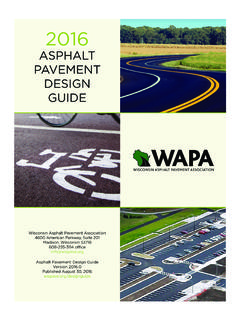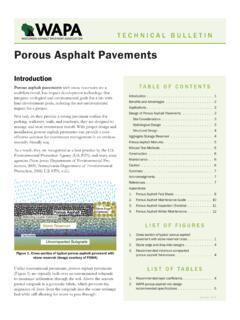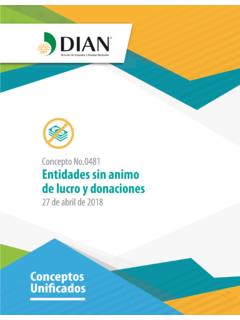Transcription of 2018 Asphalt Pavement Design Guide - wispave.org
1 2018. Asphalt . Pavement . Design . Guide . Wisconsin Asphalt Pavement Association 4600 American Parkway, Suite 201. Madison, Wisconsin 53718. 608-255-3114 office Asphalt Pavement Design Guide Version Published December 26, 2017. INSIDE FRONT COVER. Page intentionally left blank. 2018 Asphalt Pavement Design Guide FOREWORD. Foreword This 2018 Asphalt Pavement Design Guide has been New for 2018. prepared to assist readers in understanding Asphalt mix pave- This publication replaces the 2016 edition of WAPA's As- ment Design , construction, and rehabilitation. phalt Pavement Design Guide . Among other revisions and Quality Asphalt Pavement may be constructed in a wide range updates, this edition reflects the latest Design guidance in of soil, weather, and loading conditions. This Guide presents WisDOT's 2018 standard specifications. examples of designs, procedures, and applications that have Also, a major addition to this edition is the new Chapter 5, been proved successful in the state of Wisconsin.
2 All Asphalt Using WisDOT Specifications on Non-WisDOT Projects, . mixtures presented in this Design Guide are proven mixes that which outlines the impacts of including or omitting selected are readily available throughout Wisconsin from companies WisDOT specification items for smaller, non-WisDOT. experienced in producing and constructing quality Asphalt Asphalt Pavement projects. pavements. This Design Guide was developed based on information Our Objectives contained in the Wisconsin Department of Transportation's (WisDOT's) Standard Specifications and is intended for use WAPA and its members are dedicated to fulfilling the follow- by architects, engineers, developers, owners, and governmen- ing objectives: tal officials. References to authorities and agencies do not Cultivation of sound relationships and cooperative ef- constitute their endorsement of this Design Guide . If fur- fort among members, governmental agencies, and other ther clarification of the materials presented here is desired, similar organizations and associations.
3 Readers are encouraged to contact the appropriate authority, review the references cited, or contact the Wisconsin Asphalt Stimulation of public interest in the durability, sustain- Pavement Association (WAPA, online at ) or a ability, economic responsibility, safety features, and WAPA member in their area. other benefits gained through the use of Asphalt paving materials. This Design Guide has been developed to provide basic information on Asphalt pavements so readers can develop an Advocacy of sound planning in highway construction understanding of topics critical in the Design and construc- and maintenance to ensure maximum benefit from the tion of quality Asphalt pavements. WAPA cautions that the expenditure of public funds. information contained in this Design Guide may be insuf- Dissemination of information gathered from all avail- ficient when used alone. This Design Guide should be used able sources, including extensive research, related to the in concert with additional sound and established Pavement manufacture and use of Asphalt paving materials.
4 Engineering principles, Design guidance, and valid materials and traffic data. Other resource materials and authorities The ultimate quality of an Asphalt paving project is directly should be consulted when field conditions differ from those related to the experience, skill, and equipment of the con- given in this Design Guide . tractor doing the project. This is why WAPA urges consum- ers to be sure that bidders for their Asphalt paving project are This Design Guide presents background information on as- properly qualified Asphalt pavers. phalt pavements and Pavement Design considerations (Chap- ters 1 through 6). Thickness Design tables (Chapter 7) are WAPA takes pride in presenting this 2018 Asphalt Pave- presented for a variety of roadway and other uses. Informa- ment Design Guide and will be happy to provide read- tion on Pavement management systems (Chapter 8), pave- ers with additional information. ment rehabilitation (Chapter 9), special use Asphalt (Chapter 10), and materials requirements (Chapter 11) is also provided.
5 WISCONSIN Asphalt Pavement ASSOCIATION i 2018 Asphalt Pavement Design Guide . Acknowledgments This Guide updates WAPA's 2016 Asphalt Pavement Design Guide . The recent 2016 and 2018 editions build on the 2001. Asphalt Pavement Design Guide written and developed un- der the direction of Dr. James Crovetti, Marquette Univer- sity, Department of Civil and Environmental Engineering. WAPA Engineering Director Deborah Schwerman provided major updates for the recent editions of the Guide . WISCONSIN Asphalt Pavement ASSOCIATION ii 2018 Asphalt Pavement Design Guide TABLE OF CONTENTS. Table of Contents Foreword .. i Porous Asphalt ..12. New for 2018 .. i Crack-Relief Interlayers ..12. Our Objectives .. i Fiber-Reinforced Asphalt .. 12. Acknowledgments .. ii 5. Using WisDOT Specifications on Non-WisDOT Projects ..13. 1 Introduction .. 1 Mixture Sampling and Testing ..13. 2 Quality Asphalt Pavements .. 2 Nuclear Density Testing .. 14. Quality Management Program .. 2 PG Binder and Tack Coat Sampling and Testing.
6 14. Verification Testing .. 2 Ride Quality Testing ..14. Asphalt Pavement Structures .. 2 Cold Weather Paving ..14. Asphalt with Aggregate Bases .. 2 6. Pavement Design Considerations .. 15. Full-Depth Asphalt .. 3 Traffic Loadings ..15. Pavement Smoothness .. 3 Traffic Classifications ..15. International Roughness Index .. 3 ESAL Calculations .. 16. 3 Materials for Asphalt Pavements .. 4 Calculation Procedure 1 .. 16. Asphalt Cement Binder .. 4 Calculation Procedure 2 .. 16. Emulsified Asphalts .. 4 Simplified Procedure .. 16. Cutback Asphalts .. 4 Subgrade Support .. 17. Asphalt Binder Grading .. 4 Subgrade Soil Classification .. 17. Performance Grading .. 4 Drainage ..18. Wisconsin Specifications .. 5 Surface Drainage .. 18. Aggregates .. 6 Subsurface Drainage ..18. Natural Aggregates .. 6 Synthetic Subgrade Improvements .. 18. Recycled Aggregates .. 6 Edge Treatment ..19. Synthetic Aggregates .. 6 Safety EdgeSM .. 19. Aggregates for Base Courses .. 6 7. Thickness Guides for Asphalt Pavements.
7 20. Desirable Properties of Aggregates Used for Base Courses .. 6 How to Use the Design Tables ..20. Gradation .. 7 8. Pavement Management Systems .. 22. Aggregates for Asphalt Mixtures .. 7 Establishing a Pavement Management System ..22. Desirable Properties of Aggregates for Asphalt Pavements .. 7 Asphalt PASER Manual ..23. 4. Asphalt Mix Design .. 9 How to Use the PASER System ..23. What is an Asphalt Mix Design ? .. 9 9. Pavement Rehabilitation ..24. Properties Considered in Mix Design .. 9 Asphalt Osverlays ..24. WisDOT Asphalt Pavement Types ..10 Thin Lift Asphalt Overlays ..24. Aggregates for Asphalt Layers ..10 Structural Asphalt Overlays ..25. Asphalt Layer Thickness ..10 Open-Graded Friction Courses ..25. Job Mix Formula .. 11 Surface Preparation Methods ..25. WisDOT Asphalt Design Specifications ..11 Localized Surface Preparation ..25. Asphalt Compaction .. 11 Asphalt Cold Milling ..25. Air Void Regression .. 12 In-Place Recycling (Pulverizing or Full-Depth Reclamation).
8 26. Specialty Mixes ..12 Cold In-Place Recycling ..26. Warm Mix Asphalt ..12 Concrete Pavement Preparation ..26. WISCONSIN Asphalt Pavement ASSOCIATION iii 2018 Asphalt Pavement Design Guide TABLE OF CONTENTS. 10. Asphalt for Recreational and Industrial Uses ..28. Sidewalks and Walkways .. 28. List of Figures Bicycle and Golf Cart Paths .. 28. Play Areas ..28 Asphalt Pavement Types .. 3. Curbs ..28 Emulsified Asphalt .. 4. Tennis Courts ..28 Typical Zones of Traffic Classes (TCs) ..17. Asphalt -Rubber Running Tracks ..28 Safety Edge ..19. Asphalt for Hydraulic Structures ..29 Relationship of Asphalt Deterioration and Rehabilitation ..23. Agricultural Applications ..29. Railroad Track Beds .. 29. 11. Materials Requirements Table .. 30. 12. References ..28. Wisconsin Department of Transportation (WisDOT) ..31. Transportation Information Center, University of Wisconsin .. 31. Additional Government Resources ..31. Additional Engineering and Research Resources ..31. Additional Industry Resources.
9 32. List of Tables Comparable Binder Grades .. 6. Base Course Aggregate: Gradation Requirements .. 7. Asphalt Mixture Aggregate Gradation Ranges .. 8. WisDOT Asphalt Pavement Classification by Traffic Level (20-year ESAL) .. 10. WisDOT Thickness Specifications for Individual Asphalt Layers ..11. Asphalt Mixture Requirements .. 11. WisDOT Minimum Required Density .. 12. WisDOT Truck Types and Designations ..15. Pavement ESAL Factors ..15. Simplified Assignment of Traffic Class and 20-Year Design ESALs .. 16. Pavement Thickness for Traffic Class I ..20. Pavement Thickness for Traffic Class II ..20. Pavement Thickness for Traffic Class III .. 21. Pavement Thickness for Traffic Class IV .. 21. Pavement Thickness for Traffic Class V ..21. Approximate Asphalt Material Weight ..30. WISCONSIN Asphalt Pavement ASSOCIATION iv 2018 Asphalt Pavement Design Guide CHAPTER 1 INTRODUCTION. 1 Introduction Asphalt pavements have many advantages over Pavement Smooth Asphalt pavements provide a more uniform surfaces constructed using other materials.
10 Ninety-four per- surface and a quiet ride unmatched by other pavements. cent of the roads in America are surfaced with Asphalt , and Smooth Asphalt roads also reduce rolling resistance (the it's no surprise why. Asphalt pavements are: friction between tires and Pavement ), which means bet- ter fuel economy and reduced carbon dioxide emissions. Durable Asphalt pavements have long lives. All Asphalt Smooth roads allow superior contact with vehicle tires for pavements have a bridging action and are flexible, which a safer and more enjoyable ride. means they can withstand occasional overloads without serious damage. Ice- and snow-removal chemicals do not Attractive Asphalt pavements have no built-in, unsightly harm them either. cracks. They blend with and enhance the natural sur- roundings. Economical Asphalt pavements can be designed for a range of intended uses. There's no need to use a prede- Recyclable Asphalt pavements are 100 percent recyclable. termined Pavement thickness when conditions permit Not only can the aggregate be reused, the Asphalt cement otherwise.








